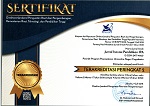Beyond Civilizational Dilague, Nipponshi: Ruang Lingkup Identitas Nasional Bangsa Indonesia
Abstract
Keywords
Full Text:
PDFReferences
Bey, A. (2003). Beyond Civilizational Dialogue, Multicultural Symbiosis in the service of World Politics. Jakarta: Paramadina.
Adha, M. M & Hiddayah, Y. (2020). Jepang, Identitas Bangsa dan Agama: Manifestasi Nilai Tradisi Lokal dalam Kehidupan Masyarakat Global. Jurnal Pendidikan Kewarganegaraan, 10 (1): 16-28.
Adha, M. M., Budimansyah, D., Sapriya., & Sundawa, D. (2019). Emerging Volunteerism for Indonesian Millennial Generation: Volunteer Participation and Responsibility. Journal of Human Behavior in the Social Environment, 29 (4): 467-483.
Adha, M. M. (2019a). Pengembangan Keadaban Kewarganegaraan melalui Festival Krakatau. Disertasi. Sekolah Pascasarjana Universitas Pendidikan Indonesia: Tidak diterbitkan.
Adha, M. M. (2019b). Warga Negara Muda Era Modern Pada Konteks Global-Nasional: Perbandingan Dua Negara Jepang dan Inggris. Jurnal Media Komunikasi Pendidikan Pancasila dan Kewarganegaraan, 1 (1): 43-53.
Adha, M. M. (2015). Pendidikan Kewarganegaraan Mengoptimalkan Pemahaman Perbedaan Budaya Warga Masyarakat Indonesia dalam Kajian Manifestasi Pluralisme di Era Globalisasi. Jurnal Ilmiah Mimbar Demokrasi, 14 (2): 1-10.
Bochner, S. (1982). Cultures in Contact: Studies in Cross-Cultural Interaction. Pergamon Press: Oxford.
Chan, J. (2008). Another Japan is Possible: New Social Movements and Global Citizenship Education. Stanford: Stanford University Press.
Erbas, I. (2013). Perception of Cultural Diversity. Academic Journal of Interdisiplinary Studies, 2 (11): 186-192.
Furlong, A. (2008). The Japanese Hikikomori Phenomenon: Acute Social Withdrawal among Young People. The Sociological Review, 56 (2): 310–325.
Jou. (2014). Basic of Japanese Culture (Japanese Culture). [Online]. Diakses tanggal 10 Oktober 2019 darihttp://iml.jou.ufl.edu/projects/Spring01/Newsome/culture.html.
Kakiuchi, E & Takeuchi, K. (2014). Creative Industries: Reality and Potential in Japan. GRIPS Discussion Paper at National Graduate Institute for Policy Studies on April 2014, Tokyo, Japan.
Khaldi, K. (2017). Quantitative, Qualitative or Mixed Research: Which Research Paradigm to Use?. Journal of Educational and Social Research, 7 (2): 15-24.
Korhonen, P. (2013). Leaving Asia? The Meaning of Datsu-A and Japan’s Modern History. The Asia-Pacific Journal, 11 (50).
Mishra, S & Kumar, C. B. (2014). Understanding Diversity: A Multicultural Perspective. Journal of Humanities and Soci
Liu, Z. (2008). The Relations between Nationalism and Islam in Middle East. Journal of Middle Eastern and Islamic Studies, 2 (1): 69-78.
McMillan, J. H & Schumacher, S. (2001). Research in Education: A Conceptual Introduction. New York: Wesley Longman.al Science, 19 (9): 62-66.
Savenye, W. C & Robinson, R. S. (1996). Qualitative Research Issues and Methods: AN Introduction for Educational Technologists. [Online]. Diakses tanggal 18 Maret 2020, dari: http://www.scholar.google.com.
Shin’ichi, K. (2020). Japan’s Identity and What It Means. [Online]. Diakses tanggal 21 Maret 2020 dari: http://www.jfir.or.jp/.
Yamada, K. (1991). Creativity in Japan. Leadership & Organization Development Journal, 12 (6): 11-14.
Yusof, S. M & Othman, R. (2016). Leadership for Creativity and Innovation. Is Japan Unique?. Journal of Advanced Management Science, 4 (2): 176-180.
DOI: http://dx.doi.org/10.17977/um019v5i2p340-347
Refbacks
- There are currently no refbacks.
Copyright (c) 2021 Jurnal Ilmiah Pendidikan Pancasila dan Kewarganegaraan

This work is licensed under a Creative Commons Attribution 4.0 International License.
View My Stats










